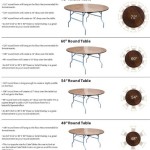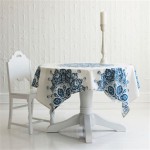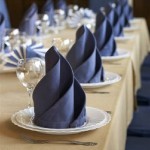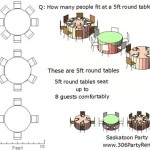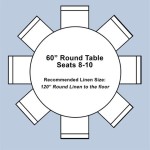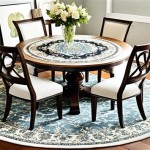How To Fold A Rectangular Tablecloth
Folding a rectangular tablecloth neatly is a foundational skill for maintaining household linens and ensuring proper storage. A well-folded tablecloth minimizes creases, saves space, and makes it easier to retrieve for future use. While there are variations in technique depending on the thickness of the fabric and the desired level of compactness, the underlying principles remain consistent: accuracy, precision, and attention to detail. This article provides a comprehensive guide to achieving a professional-looking fold for rectangular tablecloths.
Preparation and Initial Steps
Before initiating the folding process, several preparatory steps are crucial. First, ensure the tablecloth is clean and free of any stains or debris. Launder the tablecloth according to the fabric's care instructions, paying close attention to the drying process. Ideally, a tablecloth should be slightly damp when ironed, as this facilitates the removal of wrinkles and helps set the folds. If ironing is not possible, ensure the tablecloth is completely dry before folding to prevent mildew growth, particularly in humid environments.
Select a clean, flat surface for the folding process. A large table or a cleared section of the floor is suitable. The surface should be large enough to accommodate the entire length of the tablecloth without bunching or dragging. Remove any obstructions that might interfere with the folding process. Good lighting is also essential to ensure accuracy and visibility throughout the process.
Once the tablecloth is clean, dry, and the workspace is prepared, lay the tablecloth flat on the chosen surface. Ensure the tablecloth is unfolded completely, with all corners and edges aligned. Smooth out any remaining wrinkles or creases with hands, paying particular attention to the edges and corners. A smooth, flat surface is essential for achieving clean, even folds.
The Basic Folding Method: Halving and Quartering
The most common and efficient method for folding a rectangular tablecloth involves a series of halving and quartering folds. This technique produces a compact, manageable package that is easy to store. Begin by folding the tablecloth in half lengthwise. Align the two long edges precisely, ensuring they overlap perfectly. Run a hand along the folded edge to create a sharp, defined crease.
Next, fold the tablecloth in half again, this time bringing the two short edges together. Again, ensure precise alignment of the edges and create a sharp crease along the fold. At this point, the tablecloth is folded into a rectangle that is one-quarter of its original size. Evaluate the folded rectangle for any unevenness or misalignments. Adjust the folds as necessary to achieve a uniform shape.
The subsequent folds depend on the desired final size and storage method. For a more compact fold, the rectangle can be folded in half or thirds. Folding in half involves bringing the two short edges of the rectangle together, creating a smaller rectangle. Folding in thirds involves dividing the length of the rectangle into three equal sections and folding the outer sections towards the center, similar to folding a business letter. Choose the folding method that best suits the available storage space and the desired level of neatness.
Regardless of the chosen folding method, emphasis should be placed on creating sharp, even creases. Use hands to press firmly along each fold, ensuring a well-defined edge. This not only improves the appearance of the folded tablecloth but also helps maintain its shape during storage. Consistent creasing contributes to a professional and presentable outcome.
Alternative Folding Techniques and Considerations
While the halving and quartering method is widely used, alternative techniques can be employed to adapt to specific storage requirements or personal preferences. One such technique involves rolling the tablecloth instead of folding it. Rolling can be advantageous for delicate fabrics that are prone to creasing or for storing tablecloths in drawers or bins where space is limited.
To roll a tablecloth, begin by folding it in half lengthwise, as in the standard method. Then, instead of folding it further, begin rolling it tightly from one end to the other. Ensure the roll is uniform and compact. Securing the rolled tablecloth with a ribbon or elastic band helps maintain its shape and prevents it from unrolling. Rolling is particularly effective for preserving the integrity of intricate embroidery or delicate lace.
Another alternative technique involves folding the tablecloth around a cardboard tube or a length of foam. This method can help prevent creases and maintain the shape of the tablecloth, especially for special occasion linens that are not used frequently. Begin by placing the tube or foam along one short edge of the tablecloth. Then, fold the edge over the tube and continue rolling the tablecloth around it. Secure the ends of the tablecloth with pins or clips to prevent it from unraveling.
The choice of folding technique should also consider the fabric of the tablecloth. Delicate fabrics, such as silk or linen, may benefit from gentler folding methods or rolling to minimize creasing. Sturdy fabrics, such as cotton or polyester, can withstand more rigorous folding techniques. Always consult the fabric's care instructions before choosing a folding method.
Storing the folded tablecloth properly is as important as the folding technique itself. Store tablecloths in a clean, dry place away from direct sunlight and extreme temperatures. Acid-free tissue paper can be placed between the folds to further protect the fabric and prevent creasing. Avoid storing tablecloths in plastic bags, as this can trap moisture and lead to mildew growth. Instead, use breathable fabric bags or storage containers.
Addressing Specific Challenges and Fabric Types
Specific challenges may arise when folding tablecloths made from certain fabrics or with particular embellishments. For example, tablecloths with heavy embroidery or appliqués may require extra care to prevent damage to the embellishments. When folding such tablecloths, ensure the embellishments are protected by folding the fabric around them, preventing direct pressure or abrasion.
Tablecloths made from stretchy or slippery fabrics, such as satin or jersey, can be difficult to fold neatly. These fabrics tend to shift and wrinkle easily. To minimize these challenges, use a non-slip surface for folding and take extra care to align the edges precisely. Applying a light mist of fabric starch can also help stiffen the fabric and make it easier to fold.
Large or oversized tablecloths can be particularly challenging to fold, especially when working alone. In such cases, enlisting the help of another person can significantly simplify the process. With two people, one can hold the edges of the tablecloth while the other folds it, ensuring even alignment and minimizing wrinkles. If assistance is not available, consider dividing the folding process into smaller, more manageable steps.
When folding tablecloths that have been stored for an extended period, it is often necessary to re-iron them before use. This helps remove any creases that may have formed during storage and restores the tablecloth to its original appearance. Ironing should be done according to the fabric's care instructions, using the appropriate heat setting and steam level.
Regularly rotating the stock of tablecloths can help prevent permanent creases and discoloration. Use the tablecloths in rotation, and refold them periodically, even if they are not being used. This helps distribute the pressure on the fabric and prevents crease lines from becoming deeply embedded. Proper folding and storage practices are essential for preserving the beauty and longevity of tablecloths.

How To Fold A Rectangular Tablecloth

How To Fold A Tablecloth Reduce Wrinkles Totally Promotional

Folding Rectangular Tablecloths Storage Tips Cv Linens

How I Fold A Rectangular Tablecloth Step By Guide Adorn The Table

How I Fold A Rectangular Tablecloth Step By Guide Adorn The Table

Folding Rectangular Tablecloths Storage Tips Cv Linens

How To Fold A Rectangular Tablecloth

How I Fold A Rectangular Tablecloth Step By Guide Adorn The Table

How To Make A Tablecloth Fit Any Table Shape Or Size O Sewing

The Folding Table Cloth 6 Ft Black Made For Tables 3072blk Home Depot
Related Posts

